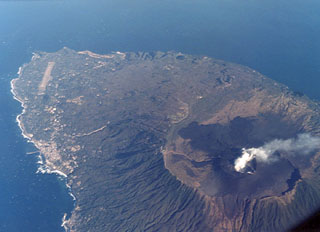Report on Izu-Oshima (Japan) — October 1987
Scientific Event Alert Network Bulletin, vol. 12, no. 10 (October 1987)
Managing Editor: Lindsay McClelland.
Izu-Oshima (Japan) Renewed explosions; ash to 2,500 m; tourists evacuated
Please cite this report as:
Global Volcanism Program, 1987. Report on Izu-Oshima (Japan) (McClelland, L., ed.). Scientific Event Alert Network Bulletin, 12:10. Smithsonian Institution. https://doi.org/10.5479/si.GVP.SEAN198710-284010
Izu-Oshima
Japan
34.724°N, 139.394°E; summit elev. 746 m
All times are local (unless otherwise noted)
On 16 November at 1047 an eruption began with two explosions that sent a black ash and gas column to at least 2,500 m above the summit. Small eruptions continued every 5-10 minutes. Roads leading to the mountain were closed and about 150 tourists and others in the summit area were evacuated to a hotel on the N side of the crater at 1100. Heavy ashfall occurred on the S part of the island and more than 30 volcanic clasts fell near a shrine on the crater rim causing several small fires. A window was broken at a tea house near the crater but there were no reports of casualties or major damage. JMA recorded >1,000 small earthquakes before the eruption, and weak earthquakes continued afterwards. During an earthquake swarm in early October [12:9] the maximum daily number of recorded earthquakes reached twice the previous maximum for 1987.
The JMSA and the Japan Maritime Self-Defense Force (JMSDF) mobilized patrol boats and escort vessels off the island.
Geological Summary. Izu-Oshima volcano in Sagami Bay, east of the Izu Peninsula, is the northernmost of the Izu Islands. The broad, low stratovolcano forms an 11 x 13 km island constructed over the remnants of three older dissected stratovolcanoes. It is capped by a 4-km-wide caldera with a central cone, Miharayama, that has been the site of numerous recorded eruptions datining back to the 7th century CE. More than 40 cones are located within the caldera and along two parallel rift zones trending NNW-SSE. Although it is a dominantly basaltic volcano, strong explosive activity has occurred at intervals of 100-150 years throughout the past few thousand years. A major eruption in 1986 produced spectacular lava fountains up to 1,600 m high and a 16-km-high eruption column; more than 12,000 people were evacuated from the island.
Information Contacts: A. Izumo, Yokohama Science Center; Japan Times, Tokyo; UPI.

